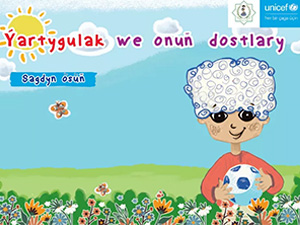"YARTYGULAK AND HIS FRIENDS" BY UNICEF TURKMENISTAN
 In May 2023, UNICEF Turkmenistan published a children’s book "Yartygulak and his friends" aimed at helping children in Turkmenistan develop healthy habits. The preparation of the book was funded by the Government of Turkmenistan and the World Bank in the framework of the Turkmenistan COVID-19 Response Project. The twenty-page book is tailored primarily for 4-10 year olds and is available in Turkmen and Russian languages.
In May 2023, UNICEF Turkmenistan published a children’s book "Yartygulak and his friends" aimed at helping children in Turkmenistan develop healthy habits. The preparation of the book was funded by the Government of Turkmenistan and the World Bank in the framework of the Turkmenistan COVID-19 Response Project. The twenty-page book is tailored primarily for 4-10 year olds and is available in Turkmen and Russian languages.
Editorial team of Saglyk.org is sharing our review of the book.
Content
Yartygulak, a popular Turkmen fairy tale character, is the main protagonist in the book. Yartygulak gives advice on how to be healthy, strong and informed. He tells kids about the benefits of keeping the indoor air clean, eating healthy, staying physically active, resting as well as maintaining healthy relationships with family and friends. Each topic section is followed by an activity, such as a word game, a riddle or a coloring exercise. The pages of the book contain illustrations related to the various topics being discussed, accompanied by Yartygulak and his friends.
A positive initiative
The book has a potential to bridge existing gaps in children’s literature and health literacy in Turkmenistan in the framework of COVID-19 response. It uses a beloved national character to promote a healthy lifestyle among children. The activities included can also keep young readers entertained as they navigate through the book. The illustrations and the colorfulness of the book is another feature that may appeal to children.
Shortcomings:
↪ Public health messaging: The book is showcased as a contribution to Turkmenistan’s COVID-19 Response project. As of December 2023, Turkmenistan has not reported any COVID-19 infections and deaths to the World Health Organization. Unfortunately, the book fails to cover basic information about COVID-19, let alone infectious diseases. It could highlight the importance of hygiene practices, mask wearing, and coping with changes, like social distancing as well as emotional challenges, like fear and anxiety during a pandemic. Children in Turkmenistan would also benefit from seeing more relatable activities in the book, such as cooking together with parents or playing hoola-hoop with friends. Moreover, such a book could be complemented with guidelines for parents and educators and information on local/reliable health resources to get more information or help.
↪ Age-appropriateness: 4-10 is a very wide age range to consider for a book as they have diverse interests, reading abilities and cognitive skills. While a 4-year-old would not be able to process long and complex sentences or solve any of the riddles in the book, a 10-year old is likely to find most of the activities and illustrations too simplistic and boring.
↪ Language: The title does not reveal any information about the content of the book which can be misleading. There is no information about the main character, Yartygulak, and neither about his friends so the reader does not get acquainted and connect with them. Yartygulak’s mixing of the singular and plural "you" when addressing the reader further disconnects the reader from him. His advice, like "stay away from ineffective and time-consuming computer games" is not only difficult to understand for younger readers, but also provides no further explanation in a child-friendly language.
↪ Illustrations: There is a lack of visual coherency in the book. The illustrations are inferior or even overshadowed by the graphic elements: as if they were created in a cheaper/low quality software. When zoomed in, we see how illustrations get pixelated or blurred, while graphics and text still maintain good visual quality. And while graphics maintain good quality visually throughout, they look generic and are not stylistically consistent. For example, coloured graphics on page 4 have significant stylised strokes while the remaining graphics on pages 6, 11, 13 and 14 do not have them.
↪ Relevance: Examples of some dishes (taco, doughnut, hotdog) and sports activities (hockey, badminton, skating) will least likely resonate with the majority of children in the country who do not have access to them in their day-to-day lives. On the contrary, it lacks representation of inclusion and diversity among the characters. Turkmenistan is a multi-ethnic country with children with different abilities. It is hard to ignore the lack of inclusiveness when we discuss the work of UNICEF, which primarily advocates for children’s rights and inclusion.
↪ Credits: There are no credits given to authors, artists or designers in the book. Disregarding the intellectual property rights and contributions of creators can be demoralizing and unfair to the individuals involved and can reflect negatively on a publisher's reputation.
While "Yartygulak and his friends" offers generic health-related content to young readers in Turkmenistan, its effectiveness is somewhat diminished by oversight in content relevance and poor design and language. It is a missed opportunity to directly address and explain COVID-19 to Turkmen children. It underscores the need for greater inclusivity and contextual alignment in children’s literature in the country. Because of this, the book will have a hard time attracting children, influencing them and serving as a valuable educational resource in Turkmenistan.
- 264 gezek okalan